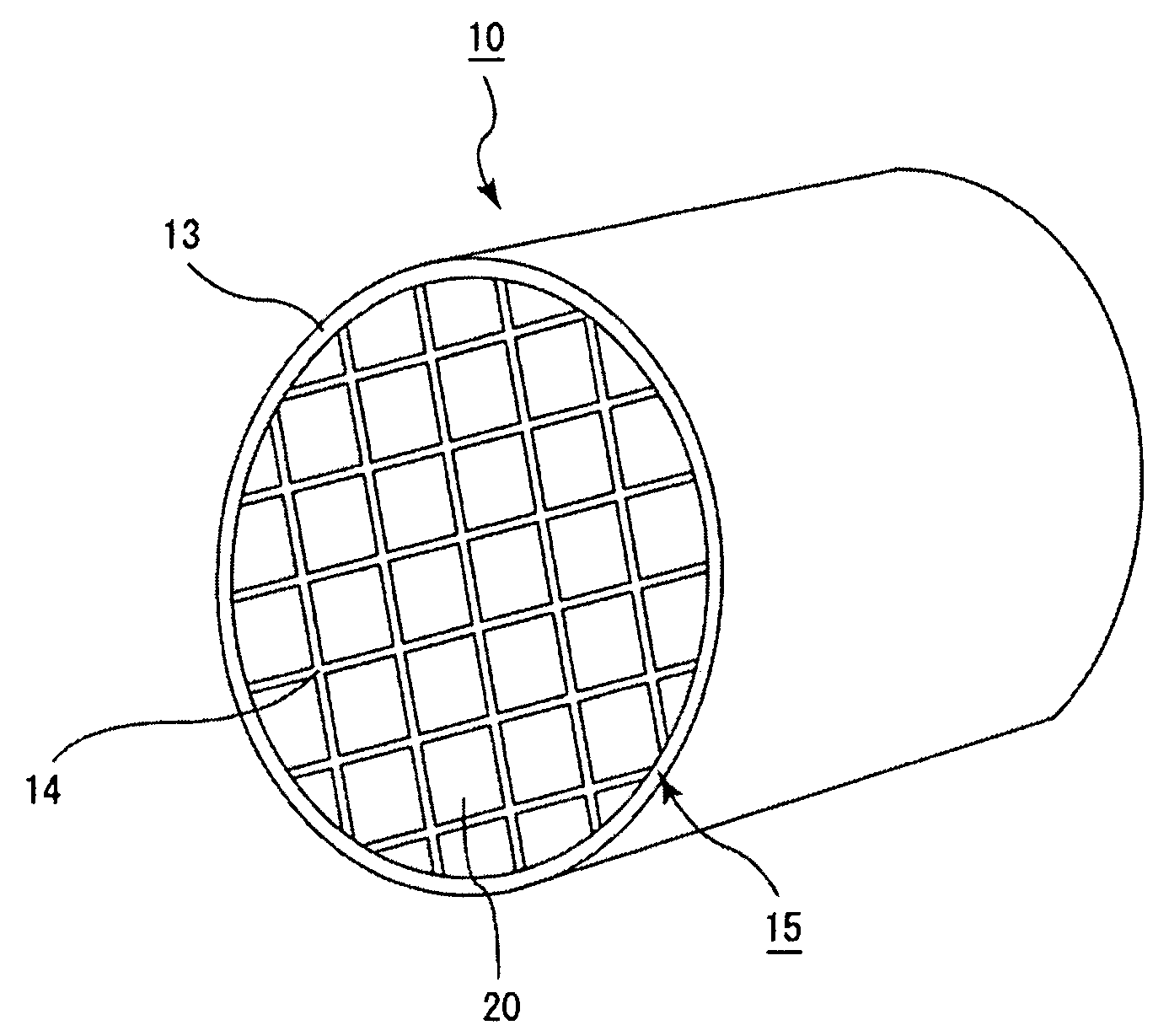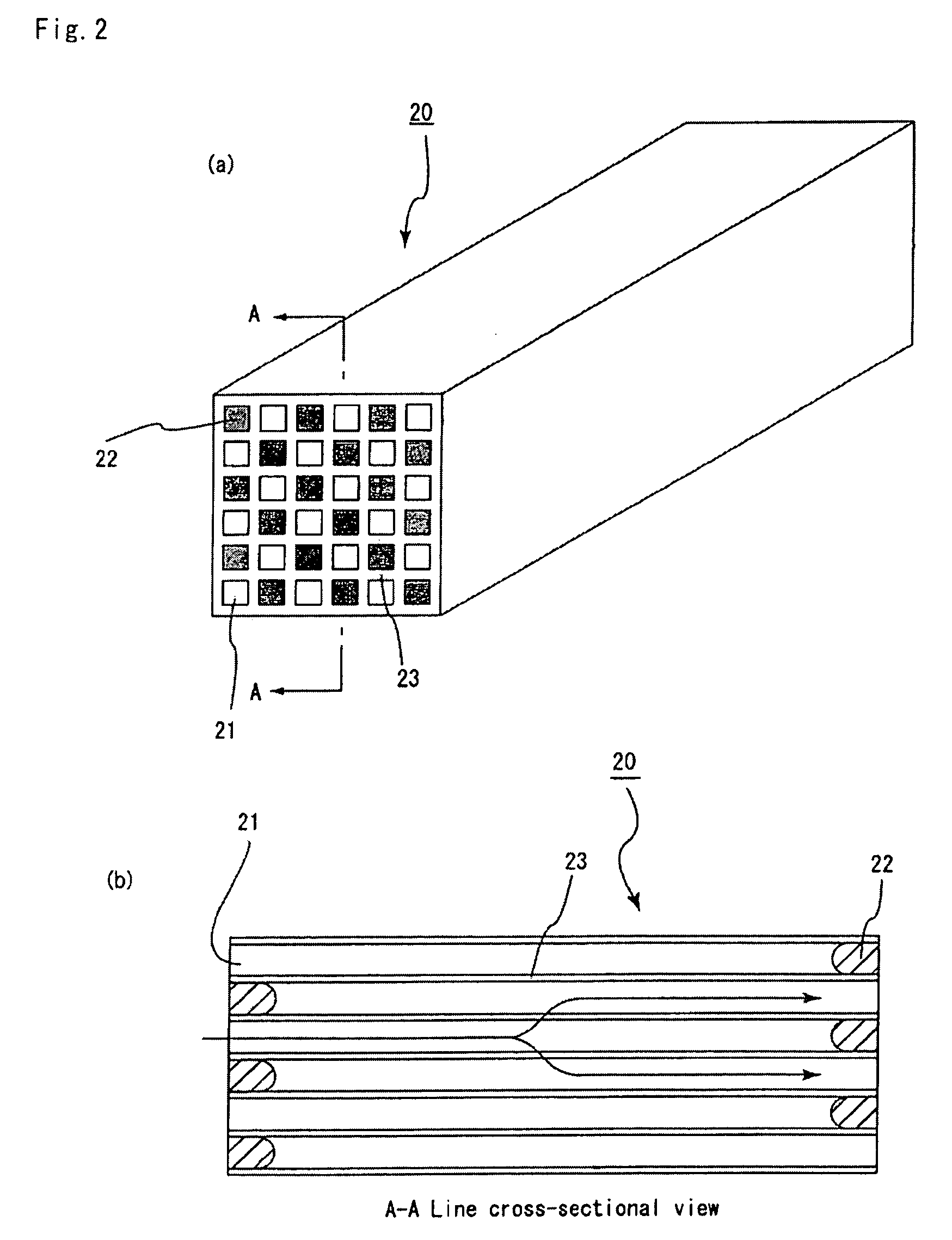Honeycomb filter for purifying exhaust gases, adhesive, coating material, and manufacturing method of honeycomb filter for purifying exhaust gases
a technology of exhaust gas and honeycomb, which is applied in the direction of combination devices, machines/engines, chemical/physical processes, etc., can solve the problems of affecting so as to reduce the permeability of gas, and reduce the permeability. , the effect of reducing the permeability
- Summary
- Abstract
- Description
- Claims
- Application Information
AI Technical Summary
Benefits of technology
Problems solved by technology
Method used
Image
Examples
example 1
[0396](1) Powder of α-type silicon carbide having an average particle size of 5 μm (60% by weight) and powder of β-type silicon carbide having an average particle size of 0.5 μm (40% by weight) were wet-mixed, and to 100 parts by weight of the resulting mixture were added and kneaded 5 parts by weight of an organic binder (methyl cellulose) and 10 parts by weight of water to obtain a kneaded matter. Next, after a slight amount of a plasticizer and a lubricant had been added to the kneaded matter and this had been further kneaded, the resulting kneaded matter was extrusion-formed so that a raw formed product was manufactured.
[0397]Next, the above-mentioned raw formed body was dried by using a microwave drier, and predetermined through holes were then filled with a paste having the same composition as the raw formed body, and after this had been again dried by using a drier, this was degreased at 400° C., and sintered at 2200° C. in a normal-pressure argon atmosphere for 3 hours to ma...
example 2
[0401](1) The same processes as (1) of Example 1 were carried out to obtain a porous ceramic member.
[0402](2) The same processes as Example 1 were carried out except that a heat-resistant adhesive paste, prepared by adding 25 parts by weight of water to 100 parts by weight of a mixture composed of 15.7% by weight of alumina fibers having a fiber length of 0.2 mm, 54.2% by weight of silicon carbide particles having an average particle size of 0.6 μm, 8.1% by weight of silica sol, 2.0% by weight of carboxymethyl cellulose and 20% by weight of ammonium hydrogencarbonate serving as a foaming agent, was used to manufacture a honeycomb filter.
example 3
[0403](1) The same processes as (1) of Example 1 were carried out to obtain a porous ceramic member.
[0404](2) The same processes as Example 1 were carried out except that a heat-resistant adhesive paste, prepared by adding 35 parts by weight of water to 100 parts by weight of a mixture composed of 13.7% by weight of alumina fibers having a fiber length of 0.2 mm, 47.4% by weight of silicon carbide particles having an average particle size of 0.6 μm, 7.1% by weight of silica sol, 1.8% by weight of carboxymethyl cellulose and 30% by weight of ammonium hydrogencarbonate serving as a foaming agent, was used to manufacture a honeycomb filter.
PUM
| Property | Measurement | Unit |
|---|---|---|
| length | aaaaa | aaaaa |
| thermal expansion coefficient | aaaaa | aaaaa |
| thermal expansion coefficient αF | aaaaa | aaaaa |
Abstract
Description
Claims
Application Information
 Login to View More
Login to View More - R&D
- Intellectual Property
- Life Sciences
- Materials
- Tech Scout
- Unparalleled Data Quality
- Higher Quality Content
- 60% Fewer Hallucinations
Browse by: Latest US Patents, China's latest patents, Technical Efficacy Thesaurus, Application Domain, Technology Topic, Popular Technical Reports.
© 2025 PatSnap. All rights reserved.Legal|Privacy policy|Modern Slavery Act Transparency Statement|Sitemap|About US| Contact US: help@patsnap.com



